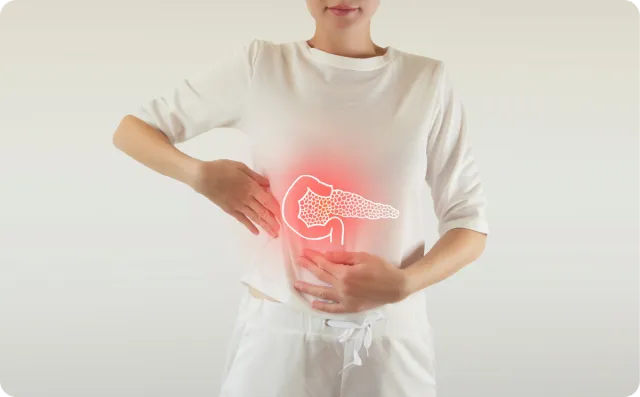
Jump to
Book a visit
$25 typical copay
$100 without insurance
Talk to a doctor about diarrhea symptoms without leaving home.
A virtual consultation for diarrhea treatment helps you get the care you need, with a licensed provider guiding you toward relief — without the need for an in-person visit.
Key takeaways:
- Yellow diarrhea has multiple causes; some of these have acute symptoms (those that come on suddenly), while others have chronic (long-lasting) symptoms.
- The presence of alarm features (warning signs) may suggest the need for a more urgent evaluation by a healthcare professional.
- Some causes of yellow diarrhea can lead to complications that may potentially be life-threatening.
Yellow diarrhea can cause much anxiety and can negatively affect your quality of life. Worrying about whether there’s a bathroom nearby at all times, having to carefully watch what you eat, wondering if you should see a healthcare professional or wait it out – it can all be very stressful. There are many possible causes of yellow diarrhea, ranging in severity from mild to potentially life-threatening.
The causes vary based on age, previous medical history, diet, medications, and other factors, such as recent travel or family history. Fortunately, there are treatment options you can try at home, although some conditions require treatment with prescription medicine. If you’re experiencing yellow diarrhea, it’s important to understand what may be causing it. Depending on what that is, you may need to see your doctor.
Is yellow diarrhea normal?
While yellow diarrhea is undoubtedly concerning, some causes may be normal. But before we talk about color, let’s look at what diarrhea is.
The simplest definition of diarrhea is a change in your poop (also called stool). It’s normally smooth and soft, but diarrhea changes it to a loose, watery consistency.
Refer to the Bristol stool chart to better visualize what this consistency may look like. You’ll see that types 6 to 7 on the chart are defined as diarrhea. Some common reasons for diarrhea to be yellow-colored will be further discussed below.
Common causes of yellow diarrhea
Although yellow diarrhea is a specific color, its causes overlap with some general causes of diarrhea. Multiple factors, including symptoms, duration of symptoms, and frequency of symptoms, can help determine which cause is more likely in your case.
Infection
The most common cause of diarrhea (regardless of color) is inflammation of the gastrointestinal (GI) tract. This is a condition known as gastroenteritis, which typically results from infection with a virus. Numerous viruses can cause viral gastroenteritis, with norovirus and rotavirus being among the most common. Bacteria, such as Clostridioides difficile (C. diff), can also cause gastroenteritis, although you may have other symptoms besides diarrhea.
Risk factors for gastroenteritis include eating contaminated or spoiled foods, contact with someone who’s infected, and recent travel history when you were exposed to contaminated water.
There is one infection that can specifically result in yellow diarrhea: giardiasis. It is caused by an intestinal parasite called Giardia. You are at increased risk for this infection if you drank or have been exposed to water that may be contaminated.
Giardiasis causes yellow diarrhea because the parasite affects your ability to digest and absorb nutrients, especially fats. This, in turn, leads to yellow, foul-smelling stools/diarrhea. If you’ve recently traveled to a location where the water is unsafe, you may have contracted giardiasis. Be sure to discuss this with your doctor.
Biliary abnormalities
The biliary system (or biliary tract) is made up of organs involved with the secretion and storage of bile. This substance is produced by the liver and plays an important role in digestion, especially the digestion of fats. Along with the liver, the biliary system includes the gallbladder and pancreas. Abnormalities of any of these organs can cause biliary issues, which may then lead to yellow diarrhea.
A common biliary problem that can lead to yellow diarrhea is gallstones, which are solid masses of bile. Gallstones can interfere with the amount of bile in the gallbladder that can reach the intestines. Because bile is produced by the liver, conditions that affect the liver (such as cirrhosis or hepatitis) can also affect your body’s ability to make bile. Similarly, any conditions that affect the pancreas (such as pancreatitis) may also cause yellow diarrhea.
Malabsorption syndromes
Malabsorption syndromes are conditions that affect the body’s ability to absorb nutrients from food or a specific type of food. Many malabsorption syndromes can lead to yellow diarrhea, including:
- Lactose intolerance, in which the body has trouble absorbing foods that contain lactose (such as dairy products);
- Celiac disease, in which the body has trouble absorbing foods with gluten;
- Any other condition that affects your ability to properly digest and absorb any of the three macronutrients: fats, proteins, and carbohydrates.
Inflammatory bowel disease
Inflammatory bowel disease (IBD) refers to conditions associated with intestinal inflammation, such as Crohn’s disease and ulcerative colitis.
Because of the underlying inflammation, your body’s ability to appropriately digest and absorb nutrients is disrupted. Similar to some previously discussed causes, you may experience yellow diarrhea with IBD. Other symptoms may include abdominal pain, fever, and unintentional weight loss.
What yellow diarrhea may mean based on appearance, consistency, or another symptom or condition
Having yellow diarrhea along with other symptoms may suggest a specific cause. Following are some possible scenarios and accompanying symptoms:
- Yellow, very liquid or water diarrhea: Suggests an infection or that you’ve ingested contaminated foods or beverages;
- Yellow diarrhea with a foul odor: Suggests malabsorption;
- Yellow diarrhea with mucus in the stool: Can occur with multiple causes of yellow diarrhea, including conditions affecting the biliary organs: gallbladder, liver, and pancreas, such as pancreatitis, gallstones, or cholecystitis;
- Yellow diarrhea accompanied by lower back pain: May suggest a more serious cause, especially if you’ve lost control of your bowels;
- Yellow diarrhea after gallbladder removal: Likely caused by changes in bile due to gallbladder surgery;
- Yellow diarrhea immediately after eating: Likely due to contaminated food or sensitivity to a specific food;
- Yellow diarrhea with a COVID diagnosis: COVID can cause multiple lingering symptoms, including diarrhea;
- Yellow diarrhea during pregnancy: Diarrhea can occur throughout pregnancy, although nausea and vomiting are more common.
Read our guide on different types of diarrhea for more.
When to see a doctor about yellow diarrhea
As discussed, yellow diarrhea can be a symptom of many possible health conditions. If you’ve experienced any of the symptoms or features noted below, you should seek further evaluation by a doctor or go to the emergency room.
You should see a doctor if:
Your symptoms occur more frequently or the volume of your bowel movements continues to increase despite the use of treatment options (described later in this article).
- You notice unintentional weight loss;
- You have significant changes in appetite;
- You’re having abdominal pain and it’s getting worse;
- You have any of the following alarm features:
- 50 years of age or older;
- Rectal bleeding;
- Pain or diarrhea during the night;
- Fever, a temperature greater than 100.4 degrees Fahrenheit;
- First-degree relative with IBD or colorectal cancer.
You should go to the emergency room if:
- You notice bright red blood in your poop or black, tarry stools;
- You experience sudden dizziness that doesn’t go away;
- You experience ongoing palpitations (the sensation of a racing heart);
- You lose control of your bowels or bladder;
- You start vomiting up blood;
- You’re unable to keep anything down, including solid food or liquids.
Questions to ask your doctor about yellow diarrhea
- Should I have bloodwork, stool studies, or other tests to assess this yellow diarrhea?
- Should I have any imaging done, like a CT or MRI?
- Should I have an endoscopy, colonoscopy, or other tests like that?
- What other treatment options or medications could help address my symptoms?
How to stop or treat yellow diarrhea
Just as there are many possible causes of yellow diarrhea, there are treatment options to help address your symptoms. If your diarrhea continues to worsen despite some of these treatment options, you should see your doctor for an in-depth evaluation.
More fiber
Adding fiber to your diet is an easy way to help treat yellow diarrhea. Fiber is an important component in food that can help better form your stools. Try eating more fiber-rich foods, such as certain fruits, vegetables, lentils, grains, and beans. Here is a longer list of high-fiber foods for you to choose from.
Anti-diarrheal medications
There are anti-diarrheal drugs, including over-the-counter medications like Pepto-Bismol, that you can use to treat your symptoms. Other medications can help slow down your gut, which may help provide additional time for digestion. This, too, could help with your symptoms.
Antibiotics
If tests show that you have a bacterial or parasitic infection, your doctor will likely prescribe antibiotics or other medications. If you have viral gastroenteritis or another viral infection, you’ll probably recover without any medications.
How to prevent yellow diarrhea
Preventing yellow diarrhea is just as important as adequately treating symptoms. Following are some suggested preventative measures:
A healthier lifestyle
Stress can negatively impact your body and worsen any health issues you may have, including diarrhea (of any color). Lifestyle modifications such as minimizing stress, exercising, and getting enough sleep can help prevent the development or worsening of your symptoms.
Hydration
Hydration is an important part of treating your yellow diarrhea as well as preventing it. Maintaining your fluid levels is essential because if you’ve been having diarrhea, you’re losing a lot of fluid. To help prevent and treat your diarrhea, make sure you are drinking plenty of fluids, including water and other drinks that contain electrolytes, such as Gatorade or Pedialyte.
Dietary modifications
If you notice that yellow diarrhea is worse after eating a specific food or group of foods, make an effort to avoid those foods. While you’re abstaining from them, monitor your symptoms to see if they improve. Keeping a food and symptom diary can be helpful as a timeline of whether changes in your diet are affecting your symptoms and how you feel.
Frequently asked questions: yellow diarrhea
There are numerous potential causes of yellow diarrhea, which can be confusing. Here are some questions people often ask, along with answers, that you may find helpful.
Is yellow diarrhea a sign of food poisoning?
It can be. As previously discussed, if you’ve developed yellow diarrhea after eating any contaminated foods, that could be the cause. Be sure to mention this to your doctor.
Is yellow diarrhea a sign of cancer?
Not necessarily, but it’s possible. If you have associated symptoms of weight loss, fatigue, and/or night sweats, discuss this with your doctor. Be sure to mention any family history of cancer, such as pancreatic cancer.
Can a stomach bug cause yellow diarrhea?
Yes it can, although not all stomach bugs cause yellow diarrhea.
Yellow diarrhea: it’s no fun
While pooping is not a huge part of your day, it can become a big nuisance when you’re suffering from diarrhea, including yellow diarrhea. There are many ways for you to get relief, however, so be sure to reach out to your primary care provider for further consultation and evaluation.
General Medicine follows a strict editorial process, including using real experts to write our articles, vetted primary sources, fact-checking, a secondary medical review, and updates as necessary. This article was medically reviewed and fact checked by Dr. Pallabi Sanyal-Dey, MD.
Sources
Beth Oller (reviewer), “How to Get More Fiber in Your Diet,” familydoctor.org, September 27, 2023. familydoctor.org/fiber-how-to-increase-the-amount-in-your-diet.
Our editorial standards
At General Medicine, we cut through the clutter to make health care clearer, faster, and easier to navigate. Every article is grounded in evidence-based research and peer-reviewed journals, reviewed by medical professionals, and written in accessible language that helps you make health decisions with confidence. We’re committed to ensuring the quality and trustworthiness of our content and editorial process by providing information that is up-to-date, accurate, and actually useful. For more details on our editorial process, see here.



